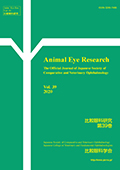
- |<
- <
- 1
- >
- >|
-
Naoya MATSUURA, Yasuhiro OTAKA, Atsumi YAMAKI, Keisuke KUDO, Soroku KU ...2020Volume 39 Pages 3-8
Published: December 25, 2020
Released on J-STAGE: December 30, 2021
JOURNAL FREE ACCESSThe clinical effects and complications of intravitreal cidofovir injection (IvCI) were evaluated for management of glaucomatous hypertensive eyes with irreversibly damaged vision in 18 dog breeds. Fifty-four glaucomatous hypertensive eyes, which did not respond to ocular hypotensive drugs, received IvCI at a dose of 500 µg / 0.1 ml under local anesthesia with topical anesthetic of 0.4 % oxybuprocaine hydrochloride (single treatment group ; STG). After the treatment, betamethasone phosphate sodium was subconjunctivally injected at a dose of 1mg, and anterior chamber centesis was performed on the eye with an intraocular pressure (IOP) of over 25 mmHg. The IOP of cidofovir-injected eyes was measured at 14, 28, and 42 days after the first IvCI treatment, and eyes with an IOP greater than 25 mmHg were injected again with cidofovir at the same dose following the same procedure after 14 days (repeated treatment group ; RTG) and underwent hyalocentesis to remove liquefied vitreous on day 28 (repeated treatment followed by hyalocentesis group ; RTHG). The median IOP of pretreatment eyes without IvCI was 51.5 mmHg. The number (%) and median IOP of the eyes in STG, RTG, and RTHG was 43 eyes (79.6 %) and 10 mmHg, 8 eyes (14.8 %) and 12.5 mmHg, and 3 eyes (5.6 %) and 9 mmHg, respectively. Complications of IvCI were phthisis bulbi (11 eyes / 20.4 %), cataract (7 eyes / 13.0 %), uveitis (4 eyes / 7.4 %), keratoconjunctivitis sicca (3 eyes / 5.6 %), ulcerative keratitis (2 eyes / 3.7 %), and non-ulcerative keratitis (1 eye / 1.9 %), although systemic complications were not noted on physical and blood examinations. This study suggested that IvCI is applicable as a therapeutic procedure for management of glaucomatous hypertensive eyes with irreversibly damaged vision in dogs.
View full abstractDownload PDF (837K) -
Tetsuya YAMAMOTO, Tatsuya OGAWA, Shuhei KATO, Osamu NAGI, Yachiyo FUKU ...2020Volume 39 Pages 9-13
Published: December 25, 2020
Released on J-STAGE: December 30, 2021
JOURNAL FREE ACCESSGöttingen minipigs of 12 males and 12 females were kept from 3- to 14-month old, and subjected to periodical examination of the eye to investigate ophthalmological background. Ununiform pigmentation of the iris was found by visual examination, and persistent pupillary membrane, persistent hyaloid artery, persistent tunica vasculosa lentis and tigroid fundus by the indirect ophthalmoscope and slit lamp biomicroscope. These findings were considered congenital. Lens opacity was noted in various forms at various regions of the lens. The lens opacity of the granular form was already present in the anterior cortex at 3-month old, and remained unchanged for the incidence and degree up until 14-month old, whereas the incidences of the opacity located in the nucleus, posterior cortex and posterior capsule appeared to increase with age of animals. Of note, the focal form of opacity localized in the posterior cortex, and granular, focal and diffuse forms of opacity in the posterior capsule became evident beyond 9-month old. From these findings, the onset of spontaneous lens opacity was carefully taken into account when evaluating toxicity studies using Göttingen minipigs.
View full abstractDownload PDF (1006K)
- |<
- <
- 1
- >
- >|